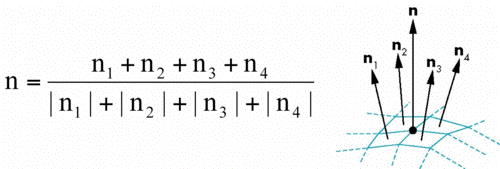chapter 6.2a
- Introduce the OpenGL shading functions
- Discuss polygonal shading
- Flat
- Smooth
- Gouraud
Steps in OpenGL shading
- Enable shading and select model
- Specify normals
- Specify material properties
- Specify lights
Normals
- In OpenGL the normal vector is part of the state
- Set by glNormal*()
glNormal3f(x, y, z);glNormal3fv(p); - Usually we want to set the normal to have
unit length so cosine calculations are correct
- Length can be affected by transformations
- Note that scaling does not preserved length
glEnable(GL_NORMALIZE)allows for autonormalization at a performance penalty
Normal for Triangle

Enabling Shading
- Shading calculations are enabled by
- glEnable(GL_LIGHTING)
- Once lighting is enabled, glColor() ignored
- Must enable each light source individually
- glEnable(GL_LIGHTi) i=0,1…..
- Can choose light model parameters
- glLightModeli(parameter, GL_TRUE)
- GL_LIGHT_MODEL_LOCAL_VIEWER do not use simplifying distant viewer assumption in calculation
- GL_LIGHT_MODEL_TWO_SIDED shades both sides of polygons independently
- glLightModeli(parameter, GL_TRUE)
- See code light.c
Defining a Point Light Source
- For each light source, we can set an RGB
for the diffuse, specular, and ambient parts, and the position
GL float diffuse0[]={1.0, 0.0, 0.0, 1.0};
GL float ambient0[]={1.0, 0.0, 0.0, 1.0};
GL float specular0[]={1.0, 0.0, 0.0, 1.0};
Glfloat light0_pos[]={1.0, 2.0, 3,0, 1.0};
glEnable(GL_LIGHTING);
glEnable(GL_LIGHT0);
glLightv(GL_LIGHT0, GL_POSITION, light0_pos);
glLightv(GL_LIGHT0, GL_AMBIENT, ambient0);
glLightv(GL_LIGHT0, GL_DIFFUSE, diffuse0);
glLightv(GL_LIGHT0, GL_SPECULAR, specular0);
Distance and Direction
- The source colors are specified in RGBA
- The position is given in homogeneous
coordinates
- If w =1.0, we are specifying a finite location
- If w =0.0, we are specifying a parallel source with the given direction vector
- The coefficients in the distance terms are by default a=1.0 (constant terms), b=c=0.0 (linear and quadratic terms).
- Change by
a= 0.80;
glLightf(GL_LIGHT0, GL_CONSTANT_ATTENUATION, a);
Spotlights
- Use glLightv to set

- Direction
- GL_SPOT_DIRECTION
- Cutoff
- GL_SPOT_CUTOFF
- Attenuation
- GL_SPOT_EXPONENT
- Proportional to cos


- Proportional to cos
- GL_SPOT_EXPONENT
- Direction
Global Ambient Light
- Ambient light depends on color of light
sources
- A red light in a white room will cause a red ambient term that disappears when the light is turned off
- OpenGL allows a global ambient term that
is often helpful
glLightModelfv(GL_LIGHT_MODEL_AMBIENT, global_ambient)
Moving Light Sources
- Light sources are geometric objects whose positions or directions are affected by the model-view matrix
- Depending on where we place the position
(direction) setting function, we can
- Move the light source(s) with the object(s)
- Fix the object(s) and move the light source(s)
- Fix the light source(s) and move the object(s)
- Move the light source(s) and object(s) independently
Material Properties
- Material properties are also part of the OpenGL state and match the terms in the Phong model
- Set by glMaterialv()
GLfloat ambient[] = {0.2, 0.2, 0.2, 1.0};
GLfloat diffuse[] = {1.0, 0.8, 0.0, 1.0};
GLfloat specular[] = {1.0, 1.0, 1.0, 1.0};
GLfloat shine = 100.0
glMaterialf(GL_FRONT, GL_AMBIENT, ambient);
glMaterialf(GL_FRONT, GL_DIFFUSE, diffuse);
glMaterialf(GL_FRONT, GL_SPECULAR, specular);
glMaterialf(GL_FRONT, GL_SHININESS, shine); - See code colormat.c
Front and Back Faces
- The default is to shade only front faces which works correctly for convex objects
- If we set two sided lighting, OpenGL will shade both sides of a surface
- Each side can have its own properties which are set by using GL_FRONT, GL_BACK, or GL_FRONT_AND_BACK in glMaterialf

Emissive Term
- We can simulate a light source in OpenGL by giving a material an emissive component
- This color is unaffected by any sources or
transformations
GLfloat emission[] = 0.0, 0.3, 0.3, 1.0);
glMaterialf(GL_FRONT, GL_EMISSION, emission);
Transparency
- Material properties are specified as RGBA values
- The A value can be used to make the surface translucent
- The default is that all surfaces are opaque regardless of A
- Later we will enable blending and use this feature
Efficiency
- Because material properties are part of the state, if we change materials for many surfaces, we can affect performance
- We can make the code cleaner by defining a material structure and setting all materials during initialization
- We can then select a material by a pointer
typedef struct materialStruct {
GLfloat ambient[4];
GLfloat diffuse[4];
GLfloat specular[4];
GLfloat shineness;
} MaterialStruct;
Polygonal Shading
- Shading calculations are done for each
vertex
- Vertex colors become vertex shades
- By default, vertex colors are interpolated across the polygon
- If we use glShadeModel(GL_FLAT); the color at the first vertex will determine the color of the whole polygon
glShadeModel(GL_SMOOTH);
Polygon Normals
- Polygons have a single normal
- Shades at the vertices as computed by the Phong model can be almost the same
- Identical for a distant viewer (default) or if there is no specular component
- Consider model of sphere
- Want different normals at each vertex even though this concept is not quite correct mathematically

Smooth Shading
- We can set a new normal at each vertex
- Easy for sphere model
- If centered at origin n = p
- Now smooth shading works
- See sphere.c , smooth.c
Note silhouette edge

Mesh Shading
- The previous example is not general because we knew the normal at each vertex analytically
- For polygonal models, Gouraud proposed we use the average of normals around a mesh vertex

Gouraud and Phong Shading
- Gouraud Shading
- Find average normal at each vertex (vertex normals)
- Apply Phong model at each vertex
- Interpolate vertex shades across each polygon
- Phong shading
- Find vertex normals
- Interpolate vertex normals across edges
- Find shades along edges
- Interpolate edge shades across polygons
Comparison
- If the polygon mesh approximates surfaces with a high curvature, Phong shading may look smooth while Gouraud shading may show edges
- Phong shading requires much more work than
Gouraud shading
- Usually not available in real time systems
- Both need data structures to represent meshes so we can obtain vertex normals
